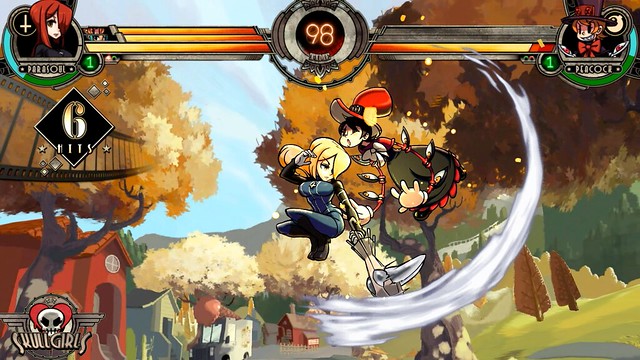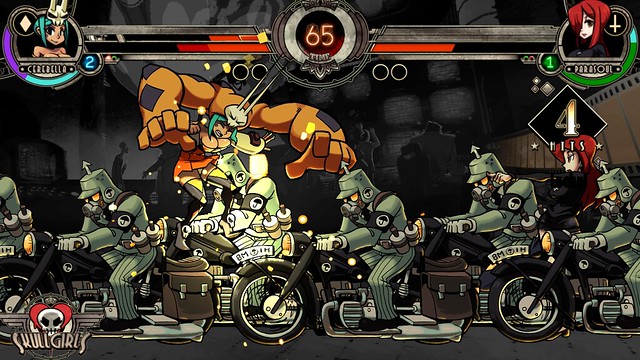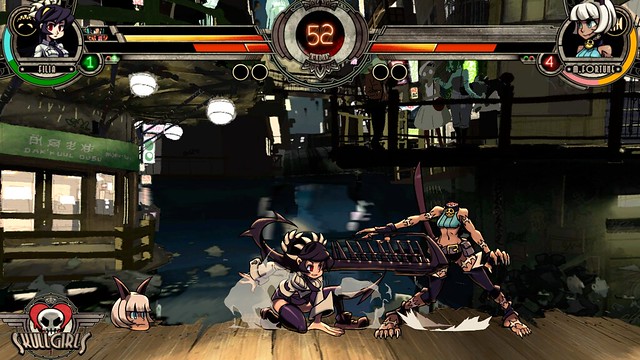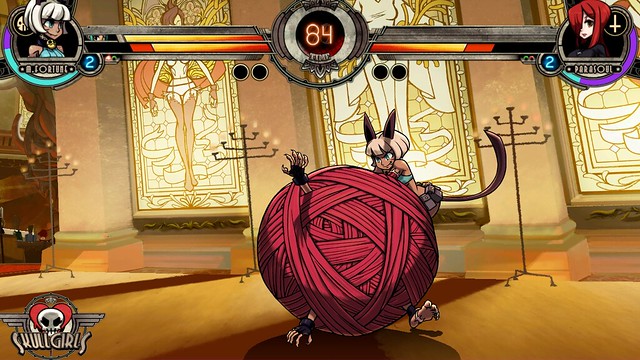A few weeks ago I gave you a run-down on our new 2D fighter, Skullgirls. Last time I discussed the game’s story and its characters, and exclusively revealed Ms. Fortune. This week we’ll be talking about the really important part: the gameplay.
As I noted last time, Skullgirls’ lead designer and programmer is Mike “Mike Z” Zaimont, a noted tournament fighter and (regretful) creator of the “real soviet damage” internet meme. While our art team strives to make the game look amazing, gameplay always comes first. Mike’s impetus to create Skullgirls was to make a game that was as fun to play as Marvel vs. Capcom 2, but addressed the system and balance problems that kept that game from being competitively viable.
The bane of many a fighter is the infinite combo: these are easily-repeated, inescapable attack patterns, and they can completely ruin games. Skullgirls gets around this by monitoring the players’ attacks, and if the game detects a looping combo the other player can break out of it free by hitting any button. Because we’ve eliminated the worst case scenario, we can free up the rest of the game in ways others have been afraid to – Skullgirls’ combo system is wide open, letting you experiment freely.
Another common problem in team-based fighters is the high/low unblockable. For example, you attack low and call a high-hitting assist attack at the same time making it impossible for your opponent to block. It’s a cheesy and frustrating tactic, and so Skullgirls has a short grace period after blocking that will guard against other hit types. You’ll still need to read your opponent and block the first attack, but at least you’ve got a fighting chance now.
While all of this was designed with the tournament scene in mind, it’s actually great for the casual player, too. If you’re new to fighting games, you can jump online without worrying about losing to these sorts of frustrating exploits – you may still lose, but at least it’ll be a fair fight you can actually learn from. That said, we’re doing everything we can to have the most comprehensive tutorials in a fighting game – we’ll not only teach you how to do things, but also why you should do them.
Being a small indie fighting game with an initial roster of eight characters, we’re giving you more ways to play with those characters. Skullgirls lets you play with mismatched team sizes of one to three characters. Single characters can give and take tons of damage, while teams are weaker but compensate with the myriad strategic benefits of multiple characters. Also, by eliminating the possibility of high/low unblockables, we’ve been able to allow custom assists and let you call on any of your teammates’ moves in battle. So despite having only eight characters, these systems give you a huge number of ways to build your team. It’s also a great way in for Street Fighter and BlazBlue players, too – if you’re not used to playing team-based games, you can start with one-character and build up to a team, or not – it’s all up to you.
Balance is something we’re taking seriously, and we’ve been aggressively play-testing the game and getting community feedback at events such as the East Coast Throwdown, the EVO Finals and Seasons Beatings. All of this is well and good, but what’s the point if you can’t play online with people? To ensure the best possible online experience, we’ve built our gameplay around the excellent GGPO networking library, the best one out there for fighting games. We’re also committed to providing free content and balance updates, as well as expanding the character roster through DLC.
Finally, a little bit of bittersweet news: as you may have heard, Skullgirls is now set for a release in early 2012. We’ve been getting tons of community feedback, and all the little tweaks and new features we’ve added delayed us a bit.
If you like what you see here, visit our website, Twitter @Skullgirls or Liking us on Facebook for the latest on the game as we approach release!
Thanks for reading!
















Comments are closed.
34 Comments
Loading More Comments